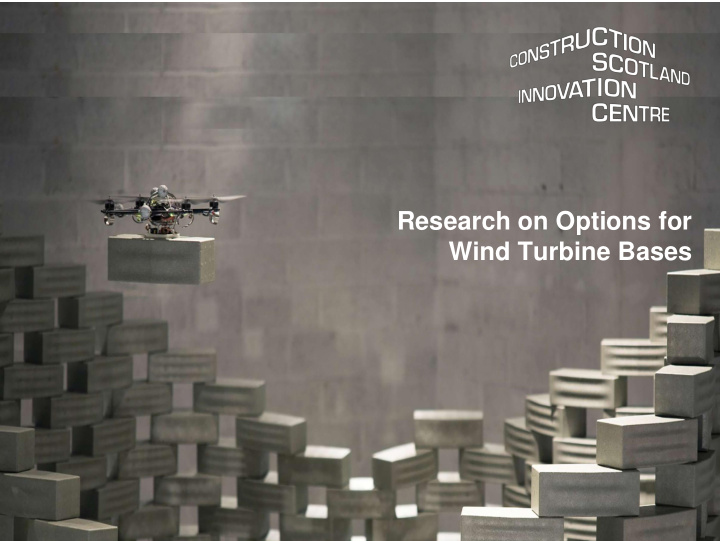



Research on Options for Wind Turbine Bases
Agenda 1. CSIC Who we are and what we do. 2. Wind Turbine Bases Understanding the Problem. 3. Collaborative Approach Working together to develop solutions. 4. Next Steps For the project, and CSIC.
CSIC Who we are, and what we do.
Stakeholders
IC family
Vision champion innovation & connect Scotland’s construction industry to deliver transformational change
CSIC stats … LAUNCHED OCTOBER £7.8M + 2014 CORE FUNDING £1.5 13 100 MILLION INDUSTRY LED + DRIVEN 9 CORE TEAM UNIVERSITY CAPITAL PARTNERS EQUIPMENT
13 HEI partners
Wind Turbine Bases Understanding the problem.
Typical Onshore Wind Turbine Base
Capital & Environmental Impact • Repowering (replacing wind turbines) within an existing wind farm is to replace it with a new concrete base and not re-use existing foundations • Capital Expense & Environmental Impact: o Original bases are left in the ground and covered with topsoil o A new base is then constructed to take the new (often larger) turbine
Capital & Environmental Impact Valuable steel and concrete is abandoned in the ground, including • significant embodied energy A new excavation is required for each new turbine base, leading to • more habitat disturbance and (often) the excavation of peat (which generates carbon emissions) Current approach necessitates a change to the wind farm layout • The old turbine bases will become a constraint to future wind farm • layouts (unless a solution is delivered in future to allow new bases to be installed on top of old ones – this is not currently possible).
Collaborative Approach Working together to develop solutions.
Industry Working Group
Feasibility Study • ENGINEERING: Identify concepts in Engineering terms (new bases and retrofit solutions): Total Lifespan 60 years Max Tipping Height to be considered Engineering design to be based on gravity base system • COSTS: Scope the comparative costs to the existing model
Feasibility Study • MANUFACTURER ENGAGEMENT: Secure Industry Buy-in leaning on existing networks • ENVIRONMENTAL IMPACT: Identify the environmental benefits Examine any long term effect of leaving the bases in situ
Next Steps For the Project, and CSIC.
Work Packages • Proposals received from members within the Working Group and responsibilities allocated: ENGINEERING: ARUP COSTS: SSE / Scottish Power Renewables ENVIRONMENTAL IMPACT: University of Glasgow MANUFACTURER ENGAGEMENT: Scottish Enterprise, SSE & Scottish Power Renewables • Initial studies to be delivered between January and February 2017 • Final report collation delivered for sign off March 2017
Funding • Project cash costs will be covered by CSIC, SEPA and SNH, in excess of £20K • Collectively all members of the working group are committing resources and time to deliver objectives • Project interest? Potential for future deliverables Interested in being involved?
CSIC Hub Industry’s Innovation Centre
34,000 SQ FT HAMILTON INTERNATIONAL TECHNOLOGY PARK
Prototyping + Training Workshop
Seminar / Training / Event Space
Open Access Drop In Collaboration Space
Thank You hello@cs-ic.org 0141 212 5250 www.cs-ic.org @CScotIC Construction Scotland Innovation Centre
Recommend
More recommend